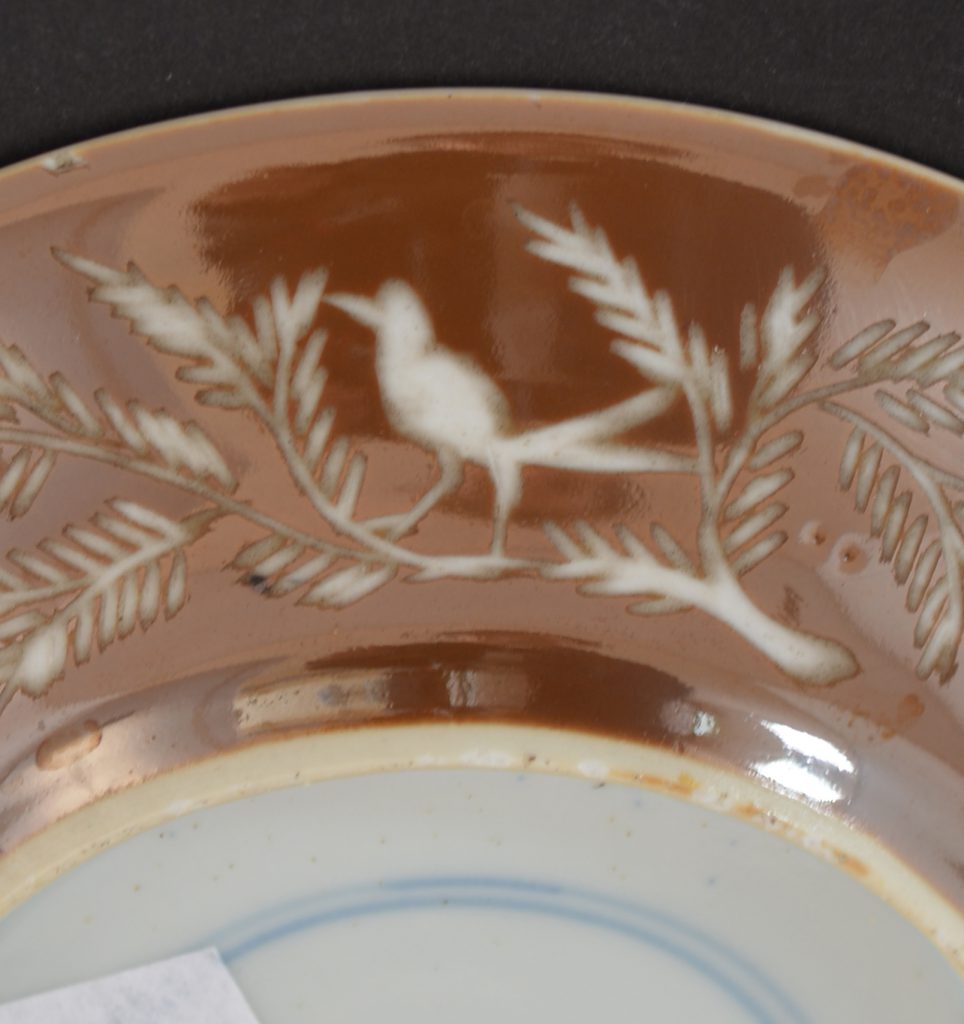
KANGXI or YONGZHENG c.1710 – 1730 Wheel – Engraved in Saxony
A Chinese Export Porcelain Teabowl and Saucer with a European Wheel Engraved Design of Cupid with an Arrow and Heart as well as Baskets of Flowers Among Foliage c.1720-1730. This Late Kangxi or Yongzheng Saucer is Decorated in Blue and White to the Interior of the Saucer with a Bird Among Flowering Plants and the Exterior is Decorated in an Iron Oxide Brown. The Matching Teabowl has Similar Decoration to the Well and the Same Wheel Engraved Decoration to the Exterior.
SOLD
- Condition
- In good condition. The saucer with a small shallow rim c.4 x 1 mm. Minute frits.
- Size
- N/A
- Provenance
- Van Stockum`s Antiquariaat-La Haye March 22nd 1952.BR> Monsieur and Madame Robert de Strycker : The Belgium couple Professor Robert de Stryker and his wife discovered Chinese art during a visit to London in the 1930`s. In 1938 they started to collect, porcelain, cloisonné, prints and lacquer, amassing a large and interesting collection with objects from the Neolithic period to the Qing dynasty. Fortunately the provenance of most of the pieces in the collection have been recorded with details the date of purchase, the name of the gallery or shop they were purchased from as well as the price paid. The De Strykers had a great passion for what they purchased but also an academic approach to their subject. Professor De Stryker exchanged a large number of letters with Harry Garner and Fritz Low-Beer as well as establishing a close relationship with the Curator of the Guimet Museum in Paris. Some pieces in their collection where shown in the exhibition `Oudekunst in Leuvensprivebezit`, this ran from July 18th to October 18th 1964.
- Stock number
- 24152
- References
- A similar Chinese Export Porcelain Teabowl and Saucer with a European Wheel Engraved. The Late Kangxi or Yongzheng Teabowl is Decorated in Blue and White to the Interior and the Exterior is Decorated in an Iron Oxide Brown. The Bowl and Saucer has then Been Wheel Engraved in Europe in c.1720 - 1730. For similar teabowls and saucers see : European Decoration on Oriental Porcelain 1700 - 1830 (Helen Espir,Jorge Welsh Books, 2005) Page 59, Item 12. Helen Espir`s notes about this teabowl and saucer ; "Fig.12 shows two Batavian cups and saucers; on the right wheel engraved with a rare hunting scene..". Wheel engraving was one of a number of techniques employed by Europeans to enliven Chinese porcelain. It is not often encountered. It is essentially a German glass decorating technique that was suited to the glaze of Chinese porcelain. By cutting deeply, the skilled engraver was able to remove the glaze completely, exposing the brilliant white porcelain, this contrasted well with the rich brown of the Batavia ware or other coloured glazes found on Chinese porcelain. Wheel engraving was practised at Dresden, Bohemia and Silesia in the 17th and 18th centuries." For more information about this technique see : European Decoration on European Porcelain 1700 - 1830 (Helen Espir,Jorge Welsh Books, 2005). For other Chinese export porcelain teabowls and saucers with wheel engraving see our `Sold Items` 17966, 17967, 20809, 22752, and a saucer shaped dish 23639.
Information
Batavia Ware :
Iron-oxide is possibly the most important colouring agent for glazes and it has been used in many ways over thousands of years to decorate Chinese ceramics. By controlling oxygen levels in the kiln as well as the amount of iron used in the glaze, a large variety of colours can be achieved. High concentrations of iron-oxide, around 5%, were used to colour the glaze to the deep rich brown that has become known as Batavia Ware, named after the V.O.C. trans-shipping town, rather than where the porcelain was made. The colour was added in the form of iron filings, occasionally one or two of them can be seen in the glaze. A Lesser amounts of iron-oxide would give the paler glaze colour known as Cafe au Lait. Both these glazes were used in conjunction with Blue and White, Famille Verte, Famille Rose as well as Imari decoration and were used on Chinese export ware during the 18th century.
Wheel-Engraving on Chinese Export Porcelain :
Wheel-engraving was one of a number of techniques employed by Europeans to enliven Chinese porcelain. It is not often encountered. It is essentially a German glass decorating technique that was suited to the glaze of Chinese porcelain. By cutting deeply, the skilled engraver was able to remove the glaze completely, exposing the brilliant white porcelain, this contrasted well with the rich brown of the Batavia ware or other coloured glazes found on Chinese porcelain. Wheel engraving was practiced at Dresden, Bohemia and Silesia in the 17th and 18th centuries. For similar teabowls and saucers with this type of decoration see : European Decoration on European Porcelain 1700 - 1830 (Helen Espir,Jorge Welsh Books, 2005) Page 59, Item 12. Helen Espir`s notes about this teabowl and saucer ; "Fig.12 shows two Batavian cups and saucers; on the right wheel engraved with a rare hunting scene..". A Teabowl and saucer with this type of decoration is on display in the Victoria and Albert Museum in London reference V&A : 306 & A-1895. It is published in : Chinese Export Ceramics (Rose Kerr, Luisa Mengoni, Ming Wilson, V&A Publishing 2011. ISBN 9781-85177-6320) page 97, plate 137.






